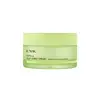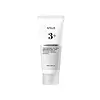What's inside
What's inside
 Key Ingredients
Key Ingredients

 Benefits
Benefits

 Ingredients Side-by-side
Ingredients Side-by-side

Water
Skin ConditioningGlycerin
HumectantDicaprylyl Ether
Emollient1,2-Hexanediol
Skin ConditioningNiacinamide
SmoothingBetaine
HumectantCaprylic/Capric Triglyceride
MaskingPolyglyceryl-3 Methylglucose Distearate
EmulsifyingPanthenol
Skin ConditioningDimethicone/Vinyl Dimethicone Crosspolymer
Skin ConditioningSodium Carbomer
Emulsion StabilisingHydroxyacetophenone
AntioxidantButylene Glycol
HumectantEthylhexylglycerin
Skin ConditioningCoptis Japonica Root Extract
Skin ConditioningPolyglyceryl-10 Myristate
Skin ConditioningTrisodium Ethylenediamine Disuccinate
Hydrogenated Lecithin
EmulsifyingHydrolyzed Hyaluronic Acid
HumectantCamellia Sinensis Leaf Water
MaskingCentella Asiatica Extract
CleansingFicus Carica Fruit Extract
HumectantGlyceryl Glucoside
HumectantMalachite Extract
AntioxidantArginine
MaskingCeramide NP
Skin ConditioningTocopherol
AntioxidantCarbomer
Emulsion StabilisingSodium Guaiazulene Sulfonate
Opuntia Ficus-Indica Stem Extract
Skin ConditioningWater, Glycerin, Dicaprylyl Ether, 1,2-Hexanediol, Niacinamide, Betaine, Caprylic/Capric Triglyceride, Polyglyceryl-3 Methylglucose Distearate, Panthenol, Dimethicone/Vinyl Dimethicone Crosspolymer, Sodium Carbomer, Hydroxyacetophenone, Butylene Glycol, Ethylhexylglycerin, Coptis Japonica Root Extract, Polyglyceryl-10 Myristate, Trisodium Ethylenediamine Disuccinate, Hydrogenated Lecithin, Hydrolyzed Hyaluronic Acid, Camellia Sinensis Leaf Water, Centella Asiatica Extract, Ficus Carica Fruit Extract, Glyceryl Glucoside, Malachite Extract, Arginine, Ceramide NP, Tocopherol, Carbomer, Sodium Guaiazulene Sulfonate, Opuntia Ficus-Indica Stem Extract
Water
Skin ConditioningPanthenol
Skin ConditioningButylene Glycol
HumectantPropanediol
SolventCaprylic/Capric Triglyceride
MaskingGlycerin
HumectantCetyl Ethylhexanoate
EmollientBehenyl Alcohol
EmollientOctyldodecanol
EmollientPhenyl Trimethicone
Skin ConditioningVinyldimethicone
1,2-Hexanediol
Skin ConditioningBis-Diglyceryl Polyacyladipate-2
EmollientPentylene Glycol
Skin ConditioningCaprylyl Methicone
Skin ConditioningCentella Asiatica Extract
CleansingPolyglyceryl-3 Methylglucose Distearate
EmulsifyingBetaine
HumectantC14-22 Alcohols
Emulsion StabilisingCeramide NP
Skin ConditioningPhytosterols
Skin ConditioningHydroxyethyl Acrylate/Sodium Acryloyldimethyl Taurate Copolymer
Emulsion StabilisingHydrogenated Rice Bran Oil
Skin ConditioningC12-20 Alkyl Glucoside
EmulsifyingAmmonium Acryloyldimethyltaurate/Vp Copolymer
Glyceryl Stearate
EmollientDimethiconol
EmollientGlyceryl Caprylate
EmollientSodium Stearoyl Glutamate
CleansingHydrogenated Lecithin
EmulsifyingGlyceryl Glucoside
HumectantAcrylates/C10-30 Alkyl Acrylate Crosspolymer
Emulsion StabilisingTromethamine
BufferingPolyglyceryl-10 Stearate
Skin ConditioningSodium Hyaluronate
HumectantEthylhexyl Olivate
Skin ConditioningDipropylene Glycol
HumectantSodium Acrylates Copolymer
Polyglyceryl-4 Oleate
EmulsifyingLinolenic Acid
CleansingPolyglyceryl-10 Laurate
Skin ConditioningSphingolipids
EmollientPhosphatidylcholine
Emulsifying4-Terpineol
MaskingAllantoin
Skin ConditioningEctoin
Skin ConditioningHyaluronic Acid
HumectantSqualane
EmollientLecithin
EmollientAsiaticoside
AntioxidantEscin
TonicMadecassic Acid
Skin ConditioningAsiatic Acid
Skin ConditioningBeta-Sitosterol
Emulsion StabilisingTremella Fuciformis Extract
HumectantCeramide AP
Skin ConditioningCeramide EOP
Skin ConditioningGlycine
BufferingGlutamic Acid
HumectantSerine
MaskingAlanine
MaskingLysine
Skin ConditioningArginine
MaskingProline
Skin ConditioningThreonine
Water, Panthenol, Butylene Glycol, Propanediol, Caprylic/Capric Triglyceride, Glycerin, Cetyl Ethylhexanoate, Behenyl Alcohol, Octyldodecanol, Phenyl Trimethicone, Vinyldimethicone, 1,2-Hexanediol, Bis-Diglyceryl Polyacyladipate-2, Pentylene Glycol, Caprylyl Methicone, Centella Asiatica Extract, Polyglyceryl-3 Methylglucose Distearate, Betaine, C14-22 Alcohols, Ceramide NP, Phytosterols, Hydroxyethyl Acrylate/Sodium Acryloyldimethyl Taurate Copolymer, Hydrogenated Rice Bran Oil, C12-20 Alkyl Glucoside, Ammonium Acryloyldimethyltaurate/Vp Copolymer, Glyceryl Stearate, Dimethiconol, Glyceryl Caprylate, Sodium Stearoyl Glutamate, Hydrogenated Lecithin, Glyceryl Glucoside, Acrylates/C10-30 Alkyl Acrylate Crosspolymer, Tromethamine, Polyglyceryl-10 Stearate, Sodium Hyaluronate, Ethylhexyl Olivate, Dipropylene Glycol, Sodium Acrylates Copolymer, Polyglyceryl-4 Oleate, Linolenic Acid, Polyglyceryl-10 Laurate, Sphingolipids, Phosphatidylcholine, 4-Terpineol, Allantoin, Ectoin, Hyaluronic Acid, Squalane, Lecithin, Asiaticoside, Escin, Madecassic Acid, Asiatic Acid, Beta-Sitosterol, Tremella Fuciformis Extract, Ceramide AP, Ceramide EOP, Glycine, Glutamic Acid, Serine, Alanine, Lysine, Arginine, Proline, Threonine
 Reviews
Reviews

Ingredients Explained
These ingredients are found in both products.
Ingredients higher up in an ingredient list are typically present in a larger amount.
1,2-Hexanediol is a synthetic liquid and another multi-functional powerhouse.
It is a:
- Humectant, drawing moisture into the skin
- Emollient, helping to soften skin
- Solvent, dispersing and stabilizing formulas
- Preservative booster, enhancing the antimicrobial activity of other preservatives
Arginine is an amino acid that is important for human development. Your body uses is it to produce hair keratin and skin collagen.
As a cosmetic ingredient, Arginine has antioxidant properties and can also help repair damaged skin. This ingredient is derived either synthetically or from animals.
Arginine isn't fungal acne safe when used in the presence of other lipids (fats, fatty acids, oils, esters, etc). Oils and fats occur naturally within the skin, so take caution when using Arginine if you're prone to fungal acne.
Learn more about ArginineBetaine is a common humectant (a substance that promotes retention of moisture). It's known to be gentle on the skin and can help balance hydration.
This ingredient is best for improving hydration and soothing irritated skin. Studies also show it helps even out skin tone.
Fun fact: Betaine is naturally created in the skin and body. The kind found within cosmetic products can be either plant-derived or synthetic.
Another name for betaine is trimethylglycine.
Learn more about BetaineButylene Glycol (or BG) is used within cosmetic products for a few different reasons:
Overall, Butylene Glycol is a safe and well-rounded ingredient that works well with other ingredients.
Though this ingredient works well with most skin types, some people with sensitive skin may experience a reaction such as allergic rashes, closed comedones, or itchiness.
Learn more about Butylene GlycolThis ingredient is an emollient, solvent, and texture enhancer. It is considered a skin-softener by helping the skin prevent moisture loss.
It helps thicken a product's formula and makes it easier to spread by dissolving clumping compounds.
Caprylic Triglyceride is made by combining glycerin with coconut oil, forming a clear liquid.
While there is an assumption Caprylic Triglyceride can clog pores due to it being derived from coconut oil, there is no research supporting this.
Learn more about Caprylic/Capric TriglycerideCentella Asiatica Extract (Centella) is derived from an herb native to Southeast Asia. It is famous for its anti-inflammatory and soothing properties.
Centella is rich in antioxidants and amino acids, such as Madecassic Acid and Asiaticoside.
Studies show the compounds in centella help with:
The combination of all these properties makes centella effective at soothing, hydrating, and protecting the skin.
Other great components of centella include Vitamin A, vitamin C, several B vitamins, and Asiatic Acid.
Fun fact: Centella has been used as a medicine and in food for many centuries. As a medicine, it is used to treat burns, scratches, and wounds.
Learn more about Centella Asiatica ExtractCeramide NP is a type of ceramide and formally known as ceramide 3.
Ceramides are intercellular lipids naturally found in our skin that bonds dead skin cells together to create a barrier. They are known for their ability to hold water and thus are a great ingredient for dry skin.
Ceramides are an important building block for our skin barrier. A stronger barrier helps the skin look more firm and hydrated. By bolstering the skin ceramides act as a barrier against irritating ingredients. This can help with inflammation as well.
If you would like to eat ceramides, sweet potatoes contain a small amount.
Read more about other common types of ceramides here:
Ceramide AP
Ceramide EOP
Glycerin is already naturally found in your skin. It helps moisturize and protect your skin.
A study from 2016 found glycerin to be more effective as a humectant than AHAs and hyaluronic acid.
As a humectant, it helps the skin stay hydrated by pulling moisture to your skin. The low molecular weight of glycerin allows it to pull moisture into the deeper layers of your skin.
Hydrated skin improves your skin barrier; Your skin barrier helps protect against irritants and bacteria.
Glycerin has also been found to have antimicrobial and antiviral properties. Due to these properties, glycerin is often used in wound and burn treatments.
In cosmetics, glycerin is usually derived from plants such as soybean or palm. However, it can also be sourced from animals, such as tallow or animal fat.
This ingredient is organic, colorless, odorless, and non-toxic.
Glycerin is the name for this ingredient in American English. British English uses Glycerol/Glycerine.
Learn more about GlycerinGlyceryl Glucoside is made from glycerol and glucose.
It is a humectant. Humectants help hydrate your skin by drawing moisture to it from the air.
Some foods that contain glyceryl glucoside include sake, miso, and wines.
Learn more about Glyceryl GlucosideHydrogenated Lecithin is created from the hydrogenation of lecithin (a group of phospholipids). Hydrogenation is a chemical reaction between hydrogen and another element.
This ingredient is an emollient and emulsifier. As an emollient, it helps soften skin by trapping moisture within. As an emulsifier, it prevents oil and water ingredients from separating.
Panthenol is a common ingredient that helps hydrate and soothe the skin. It is found naturally in our skin and hair.
There are two forms of panthenol: D and L.
D-panthenol is also known as dexpanthenol. Most cosmetics use dexpanthenol or a mixture of D and L-panthenol.
Panthenol is famous due to its ability to go deeper into the skin's layers. Using this ingredient has numerous pros (and no cons):
Like hyaluronic acid, panthenol is a humectant. Humectants are able to bind and hold large amounts of water to keep skin hydrated.
This ingredient works well for wound healing. It works by increasing tissue in the wound and helps close open wounds.
Once oxidized, panthenol converts to pantothenic acid. Panthothenic acid is found in all living cells.
This ingredient is also referred to as pro-vitamin B5.
Learn more about PanthenolPolyglyceryl-3 Methylglucose Distearate is created from the diester of stearic acid and the condensation product of methylglucose and Polyglycerin-3.
As an emulsifier, it is used to bind ingredients together. Many ingredients, such as oils and water, separate naturally. Emulsifiers prevent them from separating to ensure even consistency in texture.
One of the manufacturer for this ingredient states it is vegetable-based. It is also claimed to be stable at both high and low temperatures.
This ingredient may not be safe for fungal acne. We recommend speaking with a professional if you have any concerns.
Learn more about Polyglyceryl-3 Methylglucose DistearateWater. It's the most common cosmetic ingredient of all. You'll usually see it at the top of ingredient lists, meaning that it makes up the largest part of the product.
So why is it so popular? Water most often acts as a solvent - this means that it helps dissolve other ingredients into the formulation.
You'll also recognize water as that liquid we all need to stay alive. If you see this, drink a glass of water. Stay hydrated!
Learn more about Water